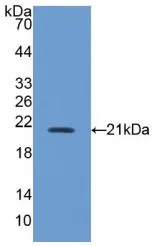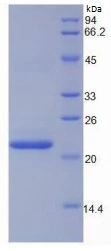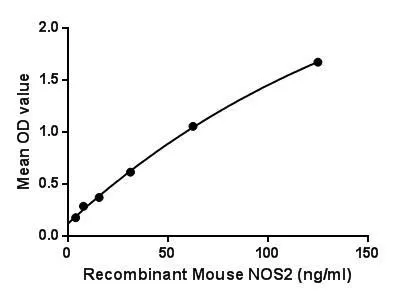
WB analysis of GTX00325-pro Mouse iNOS protein.
Mouse iNOS protein, His tag
GTX00325-PRO
ApplicationsFunctional Assay
Product group Proteins / Signaling Molecules
Protein IDP29477
Overview
- SupplierGeneTex
- Product NameMouse iNOS protein (active)
- Delivery Days Customer9
- Application Supplier NoteNitric oxide synthase 2, inducible (NOS2) is a member of Nitric oxide synthases (NOSs) family. Nitric oxide synthases (NOSs) are a family of enzymes catalyzing the production of nitric oxide (NO) from L-arginine. NO is an important cellular signaling molecule. It helps modulate vascular tone, insulin secretion, airway tone, and peristalsis, and is involved in angiogenesis and neural development. Besides, Ubiquitin Carboxyl Terminal Hydrolase L5 (UCHL5) has been identified as an interactor of NOS2, thus a binding ELISA assay was conducted to detect the interaction of recombinant mouse NOS2 and recombinant mouse UCHL5. Briefly, NOS2 was diluted serially in PBS with 0.01% BSA (pH 7.4). Duplicate samples of 100 microl were then transferred to UCHL5-coated microtiter wells and incubated for 2h at 37C. Wells were washed with PBST and incubated for 1h with anti-NOS2 pAb, then aspirated and washed 3 times. After incubation with HRP labelled secondary antibody, wells were aspirated and washed 3 times. With the addition of substrate solution, wells were incubated 15-25 minutes at 37C. Finally, add 50 microl stop solution to the wells and read at 450nm immediately. The binding activity of NOS2 and UCHL5 was in a dose dependent manner.
- ApplicationsFunctional Assay
- CertificationResearch Use Only
- ConjugateUnconjugated
- Protein IDP29477
- Protein NameNitric oxide synthase, inducible
- Scientific DescriptionNitric oxide is a reactive free radical which acts as a biologic mediator in several processes, including neurotransmission and antimicrobial and antitumoral activities. This gene encodes a nitric oxide synthase that is inducible by a combination of lipopolysaccharide and certain cytokines. Three transcript variants encoding two different isoforms have been found for this gene. [provided by RefSeq, Sep 2015]
- Storage Instruction-20°C or -80°C,2°C to 8°C
- UNSPSC12352202


